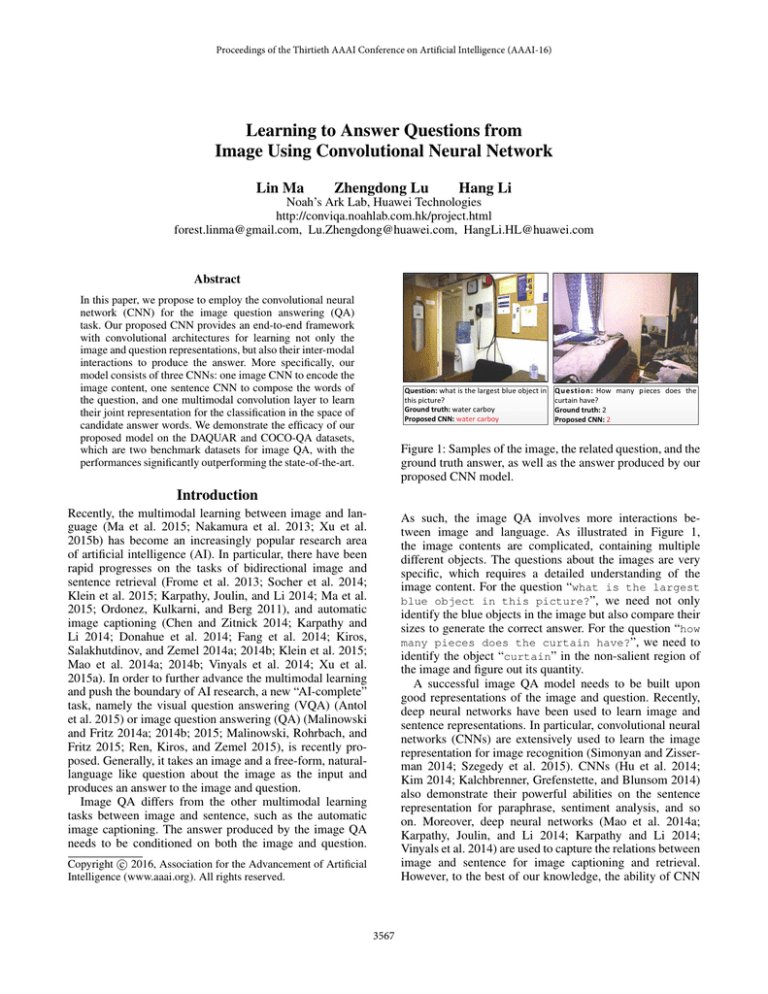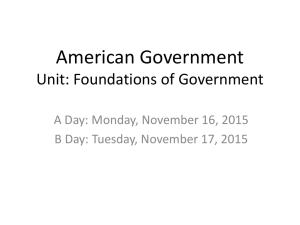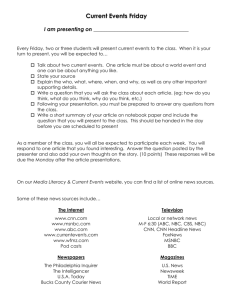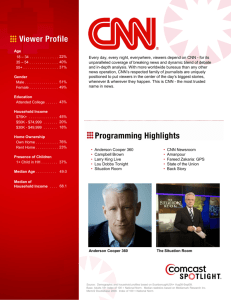
Proceedings of the Thirtieth AAAI Conference on Artificial Intelligence (AAAI-16)
Learning to Answer Questions from
Image Using Convolutional Neural Network
Lin Ma
Zhengdong Lu
Hang Li
Noah’s Ark Lab, Huawei Technologies
http://conviqa.noahlab.com.hk/project.html
forest.linma@gmail.com, Lu.Zhengdong@huawei.com, HangLi.HL@huawei.com
Abstract
In this paper, we propose to employ the convolutional neural
network (CNN) for the image question answering (QA)
task. Our proposed CNN provides an end-to-end framework
with convolutional architectures for learning not only the
image and question representations, but also their inter-modal
interactions to produce the answer. More specifically, our
model consists of three CNNs: one image CNN to encode the
image content, one sentence CNN to compose the words of
the question, and one multimodal convolution layer to learn
their joint representation for the classification in the space of
candidate answer words. We demonstrate the efficacy of our
proposed model on the DAQUAR and COCO-QA datasets,
which are two benchmark datasets for image QA, with the
performances significantly outperforming the state-of-the-art.
Question: what is the largest blue object in
this picture?
Ground truth: water carboy
Proposed CNN: water carboy
Question: How many pieces does the
curtain have?
Ground truth: 2
Proposed CNN: 2
Figure 1: Samples of the image, the related question, and the
ground truth answer, as well as the answer produced by our
proposed CNN model.
Introduction
Recently, the multimodal learning between image and language (Ma et al. 2015; Nakamura et al. 2013; Xu et al.
2015b) has become an increasingly popular research area
of artificial intelligence (AI). In particular, there have been
rapid progresses on the tasks of bidirectional image and
sentence retrieval (Frome et al. 2013; Socher et al. 2014;
Klein et al. 2015; Karpathy, Joulin, and Li 2014; Ma et al.
2015; Ordonez, Kulkarni, and Berg 2011), and automatic
image captioning (Chen and Zitnick 2014; Karpathy and
Li 2014; Donahue et al. 2014; Fang et al. 2014; Kiros,
Salakhutdinov, and Zemel 2014a; 2014b; Klein et al. 2015;
Mao et al. 2014a; 2014b; Vinyals et al. 2014; Xu et al.
2015a). In order to further advance the multimodal learning
and push the boundary of AI research, a new “AI-complete”
task, namely the visual question answering (VQA) (Antol
et al. 2015) or image question answering (QA) (Malinowski
and Fritz 2014a; 2014b; 2015; Malinowski, Rohrbach, and
Fritz 2015; Ren, Kiros, and Zemel 2015), is recently proposed. Generally, it takes an image and a free-form, naturallanguage like question about the image as the input and
produces an answer to the image and question.
Image QA differs from the other multimodal learning
tasks between image and sentence, such as the automatic
image captioning. The answer produced by the image QA
needs to be conditioned on both the image and question.
As such, the image QA involves more interactions between image and language. As illustrated in Figure 1,
the image contents are complicated, containing multiple
different objects. The questions about the images are very
specific, which requires a detailed understanding of the
image content. For the question “what is the largest
blue object in this picture?”, we need not only
identify the blue objects in the image but also compare their
sizes to generate the correct answer. For the question “how
many pieces does the curtain have?”, we need to
identify the object “curtain” in the non-salient region of
the image and figure out its quantity.
A successful image QA model needs to be built upon
good representations of the image and question. Recently,
deep neural networks have been used to learn image and
sentence representations. In particular, convolutional neural
networks (CNNs) are extensively used to learn the image
representation for image recognition (Simonyan and Zisserman 2014; Szegedy et al. 2015). CNNs (Hu et al. 2014;
Kim 2014; Kalchbrenner, Grefenstette, and Blunsom 2014)
also demonstrate their powerful abilities on the sentence
representation for paraphrase, sentiment analysis, and so
on. Moreover, deep neural networks (Mao et al. 2014a;
Karpathy, Joulin, and Li 2014; Karpathy and Li 2014;
Vinyals et al. 2014) are used to capture the relations between
image and sentence for image captioning and retrieval.
However, to the best of our knowledge, the ability of CNN
c 2016, Association for the Advancement of Artificial
Copyright Intelligence (www.aaai.org). All rights reserved.
3567
red green
on the specific image QA task has not been studied.
In this paper, we employ CNN to address the image QA
problem. Our proposed CNN model, trained on a set of
triplets consisting of (image, question, answer), can answer
free-form, natural-language like questions about the image.
Our main contributions are:
chair laptop
...
softmax
image CNN
multimodal
convolution
1. We propose an end-to-end CNN model for learning to
answer questions about the image. Experimental results
on public image QA datasets show that our proposed
CNN model surpasses the state-of-the-art.
...
sentence
CNN
2. We employ convolutional architectures to encode the
image content, represent the question, and learn the interactions between the image and question representations,
which are jointly learned to produce the answer conditioning on the image and question.
how many leftover donuts is
the red bicycle holding
Figure 2: The proposed CNN model for image QA.
Related Work
position. As such, the joint representation of image and
question is learned, which is further used for classification. However, simply treating the image as an individual
word cannot effectively exploit the complicated relations
between the image and question. Thus, the accuracy of the
answer prediction may not be ensured. In order to cope
with these drawbacks, we proposed to employ an end-toend convolutional architectures for the image QA to capture
the complicated inter-modal relationships as well as the
representations of image and question. Experimental results
demonstrate that the convolutional architectures can achieve
better performances for the image QA task.
Recently, the visual Turing test, an open domain task of
question answering based on real-world images, has been
proposed to resemble the famous Turing test. In (Gao
et al. 2015), a human judge will be presented with an
image, a question, and the answer to the question by the
computational models or human annotators. Based on the
answer, the human judge needs to determine whether the
answer is given by a human (i.e. pass the test) or a machine
(i.e. fail the test). Geman et al. (Geman et al. 2015) proposed
to produce a stochastic sequence of binary questions from a
given test image, where the answer to the question is limited
to yes/no. Malinowski et al. (Malinowski and Fritz 2014b;
2015) further discussed the associated challenges and issues
with regard to the visual Turing test, such as the vision and
language representations, the common sense knowledge, as
well as the evaluation.
The image QA task, resembling the visual Turing test,
is then proposed. Malinowski et al. (Malinowski and Fritz
2014a) proposed a multi-world approach that conducts the
semantic parsing of question and segmentation of image
to produce the answer. Deep neural networks are also employed for the image QA task, which are more related to our
research work. The work by (Malinowski, Rohrbach, and
Fritz 2015; Gao et al. 2015) formulates the image QA task
as a generation problem. Malinowski et al.’s model (Malinowski, Rohrbach, and Fritz 2015), namely the NeuralImage-QA, feeds the image representation from CNN and
the question into the long-short term memory (LSTM)
to produce the answer. This model ignores the different
characteristics of questions and answers. Compared with the
questions, the answers tend to be short, such as one single
word denoting the object category, color, number, and so on.
The deep neural network in (Gao et al. 2015), inspired by
the multimodal recurrent neural network (Mao et al. 2014b;
2014a), uses two LSTMs for the representations of question
and answer, respectively. In (Ren, Kiros, and Zemel 2015),
the image QA task is formulated as a classification problem,
and the so-called visual semantic embedding (VSE) model
is proposed. LSTM is employed to jointly model the image
and question by treating the image as an independent word,
and appending it to the question at the beginning or end
Proposed CNN for Image QA
For image QA, the problem is to predict the answer a given
the question q and the related image I:
a = argmax p(a|q, I; θ),
a∈Ω
(1)
where Ω is the set containing all the answers. θ denotes
all the parameters for performing image QA. In order to
make a reliable prediction of the answer, the question q and
image I need to be adequately represented. Based on their
representations, the relations between the two multimodal
inputs are further learned to produce the answer. In this
paper, the ability of CNN is exploited for not only modeling
the image and sentence individually, but also capturing the
relations and interactions between them.
As illustrated in Figure 2, our proposed CNN framework
for image QA consists of three individual CNNs: one image CNN encoding the image content, one sentence CNN
generating the question representation, one multimodal convolution layer fusing the image and question representations
together and generating the joint representation. Finally, the
joint representation is fed into a softmax layer to produce the
answer. The three CNNs and softmax layer are fully coupled
for our proposed end-to-end image QA framework, with all
the parameters jointly learned in an end-to-end fashion.
Image CNN
There are many research papers employing CNNs to generate image representations, which achieve the state-of-
3568
the-art performances on image recognition (Simonyan and
Zisserman 2014; Szegedy et al. 2015). In this paper, we
employ the work (Simonyan and Zisserman 2014) to encode
the image content for our image QA model:
νim = σ(wim (CN Nim (I)) + bim ),
max-pooling
(2)
convolution
where σ is a nonlinear activation function, such as Sigmoid
and ReLU (Dahl, Sainath, and Hinton 2013). CN Nim takes
the image as the input and outputs a fixed length vector
as the image representation. In this paper, by chopping
out the top softmax layer and the last ReLU layer of the
CNN (Simonyan and Zisserman 2014), the output of the last
fully-connected layer is deemed as the image representation,
which is a fixed length vector with the dimension as 4096.
Note that wim is a mapping matrix of the dimension d ×
4096, with d much smaller than 4096. On one hand, the
dimension of the image representation is reduced from 4096
to d. As such, the total number of parameters for further fusing image and question, specifically the multimodal
convolution process, is significantly reduced. Consequently,
fewer samples are needed for adequately training our CNN
model. On the other hand, the image representation is
projected to a new space, with the nonlinear activation
function σ increasing the nonlinear modeling property of
the image CNN. Thus its capability for learning complicated
representations is enhanced. As a result, the multimodal
convolution layer (introduced in the following section) can
better fuse the question and image representations together
and further exploit their complicated relations and interactions to produce the answer.
what
i+s
,
in
front
of
the
chair
...
i+srf −1
,
(5)
i
where νwd
is the word embedding of the ith word in the
question.
Max-pooling With the convolution process, the sequential
srf semantic components are composed to a higher semantic
representation. However, these compositions may not be
meaningful representations, such as “is on the” of the
question in Figure 3. The max-pooling process following
each convolution process is performed:
2i+1
i
2i
ν(+1,f
) = max(ν(,f ) , ν(,f ) ).
(6)
Firstly, together with the stride as two, the max-pooling
process shrinks half of the representation, which can quickly
make the sentence representation. Most importantly, the
max-pooling process can select the meaningful compositions while filter out the unreliable ones. As such, the
meaningful composition “of the chair” is more likely to
be pooled out, compared with the composition “front of
the”.
The convolution and max-pooling processes exploit and
summarize the local relation signals between consecutive
words. More layers of convolution and max-pooling can
help to summarize the local interactions between words
at larger scales and finally reach the whole representation
of the question. In this paper, we employ three layers
of convolution and max-pooling to generate the question
representation νqt .
(3)
−1
table
def
Multimodal Convolution Layer
where w(,f ) are the parameters for the type-f feature map
on the th layer, σ is the nonlinear activation function,
i
and ν(−1)
denotes the segment of ( − 1)th layer for the
convolution at location i , which is defined as follows.
def
the
i+1
i
i
= νwd
νwd
· · · νwd
ν(0)
Convolution For a sequential input ν, the convolution unit
for feature map of type-f on the th layer is
def
on
the whole question with a window covering srf semantic
components sliding from the beginning to the end. In this
paper, srf is chosen as 3 for the convolution process. The
input of the first convolution layer for the sentence CNN is
the word embeddings of the question:
In this paper, CNN is employed to model the question for
image QA. As most convolution models (Lecun and Bengio
1995; Kalchbrenner, Grefenstette, and Blunsom 2014), we
consider the convolution unit with a local “receptive field”
and shared weights to capture the rich structures and composition properties between consecutive words. The sentence
CNN for generating the question representation is illustrated
in Figure 3. For a given question with each word represented
as the word embedding (Mikolov et al. 2013), the sentence
CNN with several layers of convolution and max-pooling is
performed to generate the question representation νqt .
i
i
ν(−1)
+ b(,f ) ),
ν(,f
) = σ(w(,f ) is
Figure 3: The sentence CNN for the question representation.
Sentence CNN
rf
i+1
i
i
ν(−1)
= ν(−1)
ν(−1)
· · · ν(−1)
more convolution
& max-pooling
...
The image representation νim and question representation
νqt are obtained by the image and sentence CNNs, respectively. We design a new multimodal convolution layer on
top of them, as shown in Figure 4, which fuses the multimodal inputs together to generate their joint representation
for further answer prediction. The image representation is
treated as an individual semantic component. Based on the
image representation and the two consecutive semantic components from the question side, the mulitmodal convolution
(4)
where srf defines the size of local “receptive field” for
convolution. “” concatenates srf vectors into a long vector.
The parameters within the convolution unit are shared for
3569
Configuration and Training
Three layers of convolution and max-pooling are employed
for the sentence CNN. The numbers of the feature maps
for the three convolution layers are 300, 400, and 400,
respectively. The sentence CNN is designed on a fixed architecture, which needs to be set to accommodate the maximum
length of the questions. In this paper, the maximum length
of the question is chosen as 38. The word embeddings are
obtained by the skip-gram model (Mikolov et al. 2013)
with the dimension as 50. We use the VGG (Simonyan and
Zisserman 2014) network as the image CNN. The dimension
of νim is set as 400. The multimodal CNN takes the image
and sentence representations as the input and generate the
joint representation with the number of feature maps as 400.
The proposed CNN model is trained with stochastic gradient descent with mini batches of 100 for optimization, where
the negative log likelihood is chosen as the loss. During
the training process, all the parameters are tuned, including
the parameters of nonlinear image mapping, image CNN,
sentence CNN, multimodal convolution layer, and softmax
layer. Moreover, the word embeddings are also fine-tuned. In
order to prevent overfitting, dropout (with probability 0.1) is
used.
multimodal
convolution
Ă
Figure 4: The multimodal convolution layer to fuse the
image and question representations.
is performed, which is expected to capture the interactions
and relations between the two multimodal inputs.
def
i+1
in
i
= νqt
νim νqt
,
νmm
def
i
in
νmm
+ b(mm,f ) ),
ν(mm,f
) = σ(w(mm,f ) (7)
(8)
in
is the input of the multimodal convolution unit.
where νmm
i
νqt is the segment of the question representation at location
i. w(mm,f ) and b(mm,f ) are the parameters for the type-f
feature map of the multimodal convolution layer.
Alternatively, LSTM could be used to fuse the image
and question representations, as in (Malinowski, Rohrbach,
and Fritz 2015; Ren, Kiros, and Zemel 2015). For example,
in the latter work, a bidirectional LSTM (Ren, Kiros, and
Zemel 2015) is employed by appending the image representation to the beginning or end position of the question.
We argue that it is better to employ CNN than LSTM for
the image QA task, due to the following reason, which has
also been verified in the experiment section. The relations
between image and question are complicated. The image
may interact with the high-level semantic representations
composed from a number of words, such as “the red
bicycle” in Figure 2. However, LSTM cannot effectively
capture such interactions. Treating the image representation
as an individual word, the effect of image will vanish at
each time step of LSTM in (Ren, Kiros, and Zemel 2015).
As a result, the relations between the image and the highlevel semantic representations of words may not be well
exploited. In contrast, our CNN model can effectively deal
with the problem. The sentence CNN first compose the
question into a high-level semantic representations. The
multimodal convolution process further fuses the semantic
representations of image and question together and adequately exploits their interactions.
After the multimodal convolution layer, the multimodal
representation νmm jointly modeling the image and question
is obtained. νmm is then fed into a softmax layer as shown
in Figure 2, which produces the answer to the given image
and question pair.
Image QA Datasets
We test and compare our proposed CNN model on the
public image QA databases, specifically the DAQUAR (Malinowski and Fritz 2014a) and COCO-QA (Ren, Kiros, and
Zemel 2015) datasets.
DAQUAR-All (Malinowski and Fritz 2014a) This dataset
consists of 6,795 training and 5,673 testing samples, which
are generated from 795 and 654 images, respectively. The
images are from all the 894 object categories. There are
mainly three types of questions in this dataset, specifically
the object type, object color, and number of objects. The
answer may be a single word or multiple words.
DAQUAR-Reduced (Malinowski and Fritz 2014a) This
dataset is a reduced version of DAQUAR-All, comprising
3,876 training and 297 testing samples. The images are
constrained to 37 object categories. Only 25 images are used
for the testing sample generation. Same as the DAQUAR-All
dataset, the answer may be a single word or multiple words.
COCO-QA (Ren, Kiros, and Zemel 2015) This dataset
consists of 79,100 training and 39,171 testing samples,
which are generated from about 8,000 and 4,000 images,
respectively. There are four types of questions, specifically
the object, number, color, and location. The answers are all
single-word.
Evaluation Measurements
One straightforward way for evaluating image QA is to utilize accuracy, which measures the proportion of the correctly
answered testing questions to the total testing questions. Besides accuracy, Wu-Palmer similarity (WUPS) (Malinowski
and Fritz 2014a; Wu and Palmer 1994) is also used to
measure the performances of different models on the image
QA task. WUPS calculates the similarity between two words
based on their common subsequence in a taxonomy tree. A
Experiments
In this section, we firstly introduce the configuration of our
CNN model for image QA and how we train the proposed
CNN model. Afterwards, the public image QA datasets
and evaluation measurements are introduced. Finally, the
experimental results are presented and analyzed.
3570
Table 1: Image QA performances on DAQUAR-All.
Multi-World Approach
(Malinowski and Fritz 2014a)
Human Answers
(Malinowski, Rohrbach, and Fritz 2015)
Human Answers without image
(Malinowski, Rohrbach, and Fritz 2015)
Neural-Image-QA
(Malinowski, Rohrbach, and Fritz 2015)
-multiple words
-single word
Language Approach
-multiple words
-single word
Proposed CNN
-multiple words
-single word
Accuracy
WUPS
@0.9
WUPS
@0.0
7.86
11.86
38.79
50.20
50.82
67.27
11.99
16.82
33.57
17.49
19.43
23.28
25.28
57.76
62.00
17.06
17.15
22.30
22.80
56.53
58.42
21.47
24.49
27.15
30.47
59.44
66.08
Table 2: Image QA performances on DAQUAR-Reduced.
Accuracy
WUPS
@0.9
WUPS
@0.0
12.73
18.10
51.47
29.27
34.68
36.50
40.76
79.47
79.54
32.32
31.65
38.39
38.35
80.05
80.08
VSE (Ren, Kiros, and Zemel 2015)
-single word
GUESS
BOW
LSTM
IMG+BOW
VIS+LSTM
2-VIS+BLSTM
18.24
32.67
32.73
34.17
34.41
35.78
29.65
43.19
43.50
44.99
46.05
46.83
77.59
81.30
81.62
81.48
82.23
82.14
Proposed CNN
-multiple words
-single word
38.38
42.76
43.43
47.58
80.63
82.60
Multi-World Approach
(Malinowski and Fritz 2014a)
Neural-Image-QA
(Malinowski, Rohrbach, and Fritz 2015)
-multiple words
-single word
Language Approach
-multiple words
-single word
threshold parameter is required for the calculation of WUPS.
Same as the previous work (Malinowski and Fritz 2014a;
Malinowski, Rohrbach, and Fritz 2015; Ren, Kiros, and
Zemel 2015), the threshold parameters 0.0 and 0.9 are
used for the measurements WUPS@0.0 and WUPS@0.9,
respectively.
better performances for the image QA task. Moreover, the
language approach (Malinowski, Rohrbach, and Fritz 2015),
resorting to the question only, performs inferiorly to the
approaches that jointly model the image and question. The
image component is thus of great help to the image QA task.
One can also observe that the performances on “multiple
words” are generally inferior to those on “single word”.
For the DAQUAR-Reduced dataset, besides the NeuralImage-QA approach, the VSE model is also compared on
“single word”. Moreover, some of the methods introduced
in (Ren, Kiros, and Zemel 2015) are also reported and
compared. GUESS is the model which randomly outputs
the answer according to the question type. BOW treats
each word of the question equally and sums all the word
vectors to predict the answer by logistic regression. LSTM
is performed only on the question without considering the
image, which is similar to the language approach (Malinowski, Rohrbach, and Fritz 2015). IMG+BOW performs
the multinomial logistic regression based on the image
feature and a BOW vector obtained by summing all the word
vectors of the question. VIS+LSTM and 2-VIS+BLSTM
are two versions of the VSE model. VIS+LSTM uses a
single LSTM to encode the image and question in one
direction, while 2-VIS+BLSTM uses a bidirectional LSTM
to encode the image and question along with both directions
to fully exploit the interactions between image and each
word of the question. It can be observed that 2-VIS+BLSTM
outperforms VIS+LSTM with a big margin. The same observation can also be found on the COCO-QA dataset,
as shown in Table 3, demonstrating that the bidirectional
LSTM can more accurately model the interactions between
image and question than the single LSTM. Our proposed
CNN model significantly outperforms the competitor mod-
Experimental Results and Analysis
Competitor Models We compare our models with recently developed models for the image QA task, specifically
the multi-world approach (Malinowski and Fritz 2014a),
the VSE model (Ren, Kiros, and Zemel 2015), and the
Neural-Image-QA approach (Malinowski, Rohrbach, and
Fritz 2015).
Performances on Image QA The performances of our
proposed CNN model on the DAQUAR-All, DAQUARReduced, and COCO-QA datasets are illustrated in Table
1, 2, and 3, respectively. For DAQUAR-All and DAQUARReduced datasets with multiple words as the answer to the
question, we treat the answer comprising multiple words as
an individual class for training and testing.
For the DAQUAR-All dataset, we evaluate the performances of different image QA models on the full set (“multiple words”). The answer to the image and question pair
may be a single word or multiple words. Same as the
work (Malinowski, Rohrbach, and Fritz 2015), a subset
containing the samples with only a single word as the
answer is created and used for comparison (“single word”).
Our proposed CNN model significantly outperforms the
multi-world approach and Neural-Image-QA in terms of
accuracy, WUPS@0.9, and WUPS@0.0. More specifically,
our proposed CNN model achieves over 20% improvement
compared to Neural-Image-QA in terms of accuracy on
both “multiple words” and “single word”. Our CNN model,
as shown in Table. 1, can more accurately models the
image and question as well as their interactions, thus yield
3571
performance on the image QA has dropped. Comparing to
the simple concatenation process fusing the image and question representations, our proposed multimodal convolution
layer can well exploit the complicated relationships between
image and question representations. Thus a better performance for the answer prediction is achieved. Secondly, the
approach without multimodal convolution layer outperforms
the IMG+BOW, VIS+LSTM and 2-VIS+BLSTM, in terms
of accuracy. The better performance is mainly attributed to
the composition ability of the sentence CNN. Even with the
simple concatenation process, the image representation and
composed question representation can be fused together for
a better image QA model.
Table 3: Image QA performances on COCO-QA.
VSE (Ren, Kiros, and Zemel 2015)
GUESS
BOW
LSTM
IMG
IMG+BOW
VIS+LSTM
2-VIS+BLSTM
FULL
Proposed CNN without
multimodal convolution layer
Proposed CNN without
image representation
Proposed CNN
Accuracy
WUPS
@0.9
WUPS
@0.0
6.65
37.52
36.76
43.02
55.92
53.31
55.09
57.84
17.42
48.54
47.58
58.64
66.78
63.91
65.34
67.90
73.44
82.78
82.34
85.85
88.99
88.25
88.64
89.52
56.77
66.76
88.94
37.84
48.70
82.92
58.40
68.50
89.67
Influence of Image CNN and Effectiveness of Sentence
CNN As can be observed in Table 1, without the image
content, the accuracy of human answering the question
drops from 50% to 12%. Therefore, the image content is critical to the image QA task. Same as the work (Malinowski,
Rohrbach, and Fritz 2015; Ren, Kiros, and Zemel 2015),
we only use the question representation obtained from the
sentence CNN to predict the answer. The results are listed
in Table 3. Firstly, without the use of image representation,
the performance of our proposed CNN significantly drops,
which again demonstrates the importance of image component to the image QA. Secondly, the model only consisting
of the sentence CNN performs better than LSTM and BOW
for the image QA. It indicates that the sentence CNN is
more effective to generate the question representation for
image QA, compared with LSTM and BOW. Recall that the
model without multimodal convolution layers outperforms
IMG+BOW, VIS+LSTM, and 2-VIS+BLSTM, as explained
above. By incorporating the image representation, the better
modeling ability of our sentence CNN is demonstrated.
Moreover, we examine the language modeling ability of
the sentence CNN as follows. The words of the testing
questions are randomly reshuffled. Then the reformulated
questions are sent to the sentence CNN to check whether the
sentence CNN can still generate reliable question representations and make accurate answer predictions. For randomly
reshuffled questions, the results on COCO-QA dataset are
40.74, 53.06, and 80.41 for the accuracy, WUPS@0.9, and
WUPS@0.0, respectively, which are significantly inferior to
that of natural-language like questions. The result indicates
that the sentence CNN possesses the ability of modeling
natural-language like questions. The sentence CNN uses the
convolution process to compose and summarize the neighboring words. And the reliable ones with higher semantic
meanings will be pooled out and composed further to reach
the final sentence representation. As such, the sentence CNN
composes the natural-language like questions to reliable
high semantic representations.
els. More specifically, for the case of “single word”, our
proposed CNN achieves nearly 20% improvement in terms
of accuracy over the best competitor model 2-VIS+BLSTM.
For the COCO-QA dataset, IMG+BOW outperforms
VIS+LSTM and 2-VIS+BLSTM, demonstrating that the
simple multinomial logistic regression of IMG+BOW
can better model the interactions between image and
question, compared with the LSTMs of VIS+LSTM and 2VIS+BLSTM. By averaging VIS+LSTM, 2-VIS+BLSTM,
and IMG+BOW, the FULL model is developed, which
summarizes the interactions between image and question
from different perspectives thus yields a much better
performance. As shown in Table 3, our proposed CNN
model outperforms all the competitor models in terms of
all the three evaluation measurements, even the FULL
model. The reason may be that the image representation is
of highly semantic meaning, which should interact with the
high semantic components of the question. Our CNN model
firstly uses the convolutional architectures to compose
words to highly semantic representations. Afterwards,
we let the image meet the composed highly semantic
representations and use convolutional architectures to
exploit their relations and interactions for the answer
prediction. As such, Our CNN model can well model the
relations between image and question, and thus obtain the
best performances.
Influence of Multimodal Convolution Layer The image
and question need to be considered together for the image
QA. The multimodal convolution layer in our proposed
CNN model not only fuses the image and question representations together but also learns the interactions and
relations between the two multimodal inputs for further
question prediction. The effect of the multimodal convolution layer is examined as follows. The image and question
representations are simply concatenated together as the input
of the softmax layer for the answer prediction. We train
the network in the same manner as the proposed CNN
model. The results are provided in Table 3. Firstly, it can be
observed that without the multimodal convolution layer, the
Conclusion
In this paper, we proposed one CNN model to address
the image QA problem. The proposed CNN model relies on convolutional architectures to generate the image
representation, compose the question representation from
consecutive words, and learn the interactions and relations
3572
between the image and question for the answer prediction.
Experimental results on public image QA datasets demonstrate the superiority of our proposed model over the stateof-the-art methods.
Klein, B.; Lev, G.; Sadeh, G.; and Wolf, L.
2015.
Fisher vectors derived from hybrid gaussian-laplacian mixture
models for image annotation. In CVPR.
Lecun, Y., and Bengio, Y. 1995. Convolutional networks
for images, speech and time series. The Handbook of Brain
Theory and Neural Networks.
Ma, L.; Lu, Z.; Shang, L.; and Li, H. 2015. Multimodal
convolutional neural networks for matching image and
sentence. In ICCV.
Malinowski, M., and Fritz, M. 2014a. A multi-world
approach to question answering about real-world scenes based
on uncertain input. In NIPS.
Malinowski, M., and Fritz, M. 2014b. Towards a visual turing
challenge. arXiv 1410.8027.
Malinowski, M., and Fritz, M. 2015. Hard to cheat: A
turing test based on answering questions about images. arXiv
1501.03302.
Malinowski, M.; Rohrbach, M.; and Fritz, M. 2015. Ask your
neurons: A neural-based approach to answering questions
about images. arXiv 1505.01121.
Mao, J.; Xu, W.; Yang, Y.; Wang, J.; and Yuille, A. L. 2014a.
Deep captioning with multimodal recurrent neural networks
(m-rnn). arXiv 1412.6632.
Mao, J.; Xu, W.; Yang, Y.; Wang, J.; and Yuille, A. L. 2014b.
Explain images with multimodal recurrent neural networks.
arXiv 1410.1090.
Mikolov, T.; Chen, K.; Corrado, G.; and Dean, J. 2013.
Efficient estimation of word representations in vector space.
arXiv 1301.3781.
Nakamura, T.; Nagai, T.; Funakoshi, K.; Nagasaka, S.;
Taniguchi, T.; and Iwahashi, N. 2013. Mutual learning of an
object concept and language model based on mlda and npylm.
In IROS.
Ordonez, V.; Kulkarni, G.; and Berg, T. L. 2011. Im2text:
Describing images using 1 million captioned photographs. In
NIPS.
Ren, M.; Kiros, R.; and Zemel, R. S. 2015. Exploring models
and data for image question answering. arXiv 1505.02074.
Simonyan, K., and Zisserman, A.
2014.
Very deep
convolutional networks for large-scale image recognition.
arXiv 1409.1556.
Socher, R.; Karpathy, A.; Le, Q. V.; Manning, C. D.; and Ng,
A. Y. 2014. Grounded compositional semantics for finding
and describing images with sentences. In TACL.
Szegedy, C.; Liu, W.; Jia, Y.; Sermanet, P.; Reed, S.;
Anguelov, D.; Erhan, D.; Vanhoucke, V.; and Rabinovich, A.
2015. Going deeper with convolutions. In CVPR.
Vinyals, O.; Toshev, A.; Bengio, S.; and Erhan, D. 2014.
Show and tell: A neural image caption generator. arXiv
1411.4555.
Wu, Z., and Palmer, M. S. 1994. Verb semantics and lexical
selection. In ACL.
Xu, K.; Ba, J.; Kiros, R.; Cho, K.; Courville, A.; Salakhutdinov, R.; Zemel, R.; and Bengio, Y. 2015a. Show, attend and
tell: Neural image caption generation with visual attention.
arXiv 1502.03044.
Xu, R.; Xiong, C.; Chen, W.; and Corso, J. 2015b. Jointly
modeling deep video and compositional text to bridge vision
and language in a unified framework. In AAAI.
Acknowledgement
The work is partially supported by China National 973
project 2014CB340301. The authors are grateful to Baotian
Hu and Zhenguo Li for their insightful discussions and
comments.
References
Antol, S.; Agrawal, A.; Lu, J.; Mitchell, M.; Batra, D.;
Zitnick, C. L.; and Parikh, D. 2015. VQA: visual question
answering. arXiv 1505.00468.
Chen, X., and Zitnick, C. L. 2014. Learning a recurrent
visual representation for image caption generation. arXiv
1411.5654.
Dahl, G. E.; Sainath, T. N.; and Hinton, G. E. 2013. Improving
deep neural networks for LVCSR using rectified linear units
and dropout. In ICASSP.
Donahue, J.; Hendricks, L. A.; Guadarrama, S.; Rohrbach,
M.; Venugopalan, S.; Saenko, K.; and Darrell, T. 2014. Longterm recurrent convolutional networks for visual recognition
and description. arXiv 1411.4389.
Fang, H.; Gupta, S.; Iandola, F. N.; Srivastava, R.; Deng, L.;
Dollár, P.; Gao, J.; He, X.; Mitchell, M.; Platt, J. C.; Zitnick,
C. L.; and Zweig, G. 2014. From captions to visual concepts
and back. arXiv 1411.4952.
Frome, A.; Corrado, G.; Shlens, J.; Bengio, S.; Dean, J.;
Ranzato, M.; and Mikolov, T. 2013. Devise: A deep visualsemantic embedding model. In NIPS.
Gao, H.; Mao, J.; Zhou, J.; Huang, Z.; Wang, L.; and Xu, W.
2015. Are you talking to a machine? dataset and methods for
multilingual image question answering. arXiv 1505.05612.
Geman, D.; Geman, S.; Hallonquist, N.; and Younes, L. 2015.
Visual turing test for computer vision systems. In PNAS.
Hu, B.; Lu, Z.; Li, H.; and Chen, Q. 2014. Convolutional
neural network architectures for matching natural language
sentences. In NIPS.
Kalchbrenner, N.; Grefenstette, E.; and Blunsom, P. 2014.
A convolutional neural network for modelling sentences. In
ACL.
Karpathy, A., and Li, F.-F. 2014. Deep visual-semantic
alignments for generating image descriptions.
arXiv
1412.2306.
Karpathy, A.; Joulin, A.; and Li, F.-F. 2014. Deep fragment
embeddings for bidirectional image sentence mapping. In
NIPS.
Kim, Y. 2014. Convolutional neural networks for sentence
classification. In EMNLP.
Kiros, R.; Salakhutdinov, R.; and Zemel, R.
2014a.
Multimodal neural language models. In ICML.
Kiros, R.; Salakhutdinov, R.; and Zemel, R. S. 2014b. Unifying visual-semantic embeddings with multimodal neural
language models. arXiv 1411.2539.
3573






